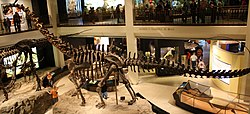
Apatosaurus is a genus of herbivorous sauropod dinosaur that lived in North America during the Late Jurassic period. Othniel Charles Marsh described and named the first-known species, A. ajax, in 1877, and a second species, A. louisae, was discovered and named by William H. Holland in 1916. Apatosaurus lived about 152 to 151 million years ago (mya), during the late Kimmeridgian to early Tithonian age, and are now known from fossils in the Morrison Formation of modern-day Colorado, Oklahoma, New Mexico, Wyoming, and Utah in the United States. Apatosaurus had an average length of 21–23 m (69–75 ft), and an average mass of 16.4–22.4 t. A few specimens indicate a maximum length of 11–30% greater than average and a mass of approximately 33 t.

Diplodocids, or members of the family Diplodocidae, are a group of sauropod dinosaurs. The family includes some of the longest creatures ever to walk the Earth, including Diplodocus and Supersaurus, some of which may have reached lengths of up to 42 metres (138 ft).

Brontosaurus is a genus of herbivorous sauropod dinosaur that lived in present-day United States during the Late Jurassic period. It was described by American paleontologist Othniel Charles Marsh in 1879, the type species being dubbed B. excelsus, based on a partial skeleton lacking a skull found in Como Bluff, Wyoming. In subsequent years, two more species of Brontosaurus were named: B. parvus in 1902 and B. yahnahpin in 1994. Brontosaurus lived about 156 to 146 million years ago (mya) during the Kimmeridgian and Tithonian ages in the Morrison Formation of what is now Utah and Wyoming. For decades, the animal was thought to have been a taxonomic synonym of its close relative Apatosaurus, but a 2015 study by Emmanuel Tschopp and colleagues found it to be distinct. It has seen widespread representation in popular culture, being the archetypal "long-necked" dinosaur in general media.
Suuwassea is a genus of dicraeosaurid sauropod dinosaur found in the Upper Jurassic strata of the Morrison Formation, located in southern Carbon County, Montana, United States. The fossil remains were recovered in a series of expeditions during a period spanning the years 1999 and 2000 and were described by J.D. Harris and Peter Dodson in 2004. They consist of a disarticulated but associated partial skeleton, including partial vertebral series and limb bones.

Diplodocoidea is a superfamily of sauropod dinosaurs, which included some of the longest animals of all time, including slender giants like Supersaurus, Diplodocus, Apatosaurus, and Amphicoelias. Most had very long necks and long, whip-like tails; however, one family are the only known sauropods to have re-evolved a short neck, presumably an adaptation for feeding low to the ground. This adaptation was taken to the extreme in the highly specialized sauropod Brachytrachelopan. A study of snout shape and dental microwear in diplodocoids showed that the square snouts, large proportion of pits, and fine subparallel scratches in Apatosaurus, Diplodocus, Nigersaurus, and Rebbachisaurus suggest ground-height nonselective browsing; the narrow snouts of Dicraeosaurus, Suuwassea, and Tornieria and the coarse scratches and gouges on the teeth of Dicraeosaurus suggest mid-height selective browsing in those taxa. This taxon is also noteworthy because diplodocoid sauropods had the highest tooth replacement rates of any vertebrates, as exemplified by Nigersaurus, which had new teeth erupting every 30 days.

Dicraeosauridae is a family of diplodocoid sauropods who are the sister group to Diplodocidae. Dicraeosaurids are a part of the Flagellicaudata, along with Diplodocidae. Dicraeosauridae includes genera such as Amargasaurus, Suuwassea, Dicraeosaurus, and Brachytrachelopan. Specimens of this family have been found in North America, Asia, Africa, and South America. In 2023, a dicraeosaurid fossil was discovered in India for the first time. Their temporal range is from the Early or Middle Jurassic to the Early Cretaceous. Few dicraeosaurids survived into the Cretaceous, the youngest of which was Amargasaurus.
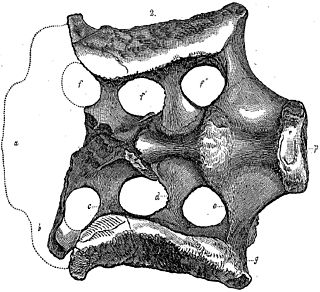
Atlantosaurus is a dubious genus of sauropod dinosaur. It contains a single species, Atlantosaurus montanus, from the upper Morrison Formation of Colorado, United States. Atlantosaurus was the first sauropod to be described during the infamous 19th century Bone Wars, during which scientific methodology suffered in favor of pursuit of academic acclaim.

Camarasaurus lewisi is a species of sauropod dinosaur from the Upper Jurassic of the United States. It was named by James A. Jensen in 1988. C. lewisi was originally placed in its own genus, Cathetosaurus, but in 1996 it was reclassified as a species of Camarasaurus; most researchers since have considered it to be one of the four valid species of Camarasaurus. Two unpublished studies have since argued that the genus Cathetosaurus should be reinstated, whereas two other studies have argued that C. lewisi may be a junior synonym of another species of Camarasaurus.
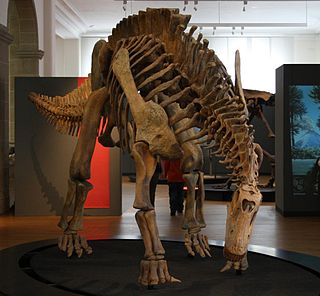
Brachytrachelopan is a short-necked sauropod dinosaur from the Late Jurassic of Argentina. The holotype and only known specimen was collected from an erosional exposure of fluvial sandstone within the Cañadón Calcáreo Formation on a hill approximately 25 kilometres (16 mi) north-northeast of Cerro Cóndor, Chubut Province, in west-central Argentina, South America. Though very incomplete, the skeletal elements recovered were found in articulation and include eight cervical, twelve dorsal, and three sacral vertebrae, as well as proximal portions of the posterior cervical ribs and all the dorsal ribs, the distal end of the left femur, the proximal end of the left tibia, and the right ilium. Much of the specimen was probably lost to erosion many years before its discovery. The type species is Brachytrachelopan mesai. The specific name honours Daniel Mesa, a local shepherd who discovered the specimen while searching for lost sheep. The genus name translates as "short-necked Pan", Pan being the god of the shepherds.
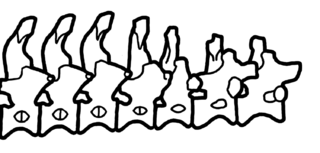
Dinheirosaurus is a genus of diplodocid sauropod dinosaur that is known from fossils uncovered in modern-day Portugal. It may represent a species of Supersaurus. The only species is Dinheirosaurus lourinhanensis, first described by José Bonaparte and Octávio Mateus in 1999 for vertebrae and some other material from the Lourinhã Formation. Although the precise age of the formation is not known, it can be dated around the early Tithonian of the Late Jurassic.

Dyslocosaurus is the name given in 1992 to a genus of sauropod dinosaur from the Late Jurassic Period of Wyoming, North America.

Dystrophaeus is an extinct genus of sauropod dinosaur. Its type and only species is Dystrophaeus viaemalae, named by Edward Drinker Cope in 1877. Its fossils were found in the Tidwell Member of the Morrison Formation of Utah. Due to the fragmentary condition of its only known specimen, the affinities of Dystrophaeus are uncertain, although excavations carried out at the discovery site since 1989 have uncovered more of the original specimen and hold the potential for an improved understanding of the taxon.

Octávio Mateus is a Portuguese dinosaur paleontologist and biologist Professor of Paleontology at the Faculdade de Ciências e Tecnologia da Universidade Nova de Lisboa. He graduated in Universidade de Évora and received his PhD at Universidade Nova de Lisboa in 2005. He collaborates with Museu da Lourinhã, known for their dinosaur collection.

Australodocus is a genus of sauropod dinosaur that lived during the Late Jurassic period, around 150 million years ago, in what is now Lindi Region, Tanzania. Though initially considered a diplodocid, recent analyses suggest it may instead be a titanosauriform.
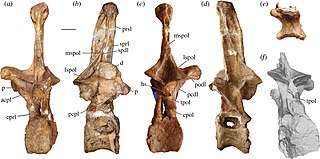
Amphicoelias is a genus of herbivorous sauropod dinosaur that lived approximately 150 million years ago during the Tithonian of what is now Colorado, United States. Amphicoelias was moderately sized at about 18 metres (59 ft) in length and 15 metric tons in body mass, shorter than its close relative Diplodocus. Its hindlimbs were very long and thin, and its forelimbs were proportionally longer than in relatives.

Diplodocus is an extinct genus of diplodocid sauropod dinosaurs known from the Late Jurassic of North America. The first fossils of Diplodocus were discovered in 1877 by S. W. Williston. The generic name, coined by Othniel Charles Marsh in 1878, is a Neo-Latin term derived from Greek διπλός (diplos) "double" and δοκός (dokos) "beam", in reference to the double-beamed chevron bones located in the underside of the tail, which were then considered unique.

Kaatedocus is a genus of flagellicaudatan sauropod known from the middle Late Jurassic of northern Wyoming, United States. It is known from well-preserved skull and cervical vertebrae which were collected in the lower part of the Morrison Formation. The type and only species is Kaatedocus siberi, described in 2012 by Emanuel Tschopp and Octávio Mateus.

Leinkupal is a genus of diplodocine sauropod known from the Early Cretaceous of the Bajada Colorada Formation, southeastern Neuquén Basin in the Neuquén Province of Argentina. It contains a single species, Leinkupal laticauda.

Galeamopus is a genus of herbivorous diplodocid sauropod dinosaurs. It contains two known species: Galeamopus hayi, known from the Late Jurassic lower Morrison Formation of Wyoming, United States, and Galeamopus pabsti, known from the Late Jurassic fossils from Wyoming and Colorado. The type species is known from one of the most well preserved diplodocid fossils, a nearly complete skeleton with associated skull.

Ardetosaurus is an extinct genus of diplodocid sauropod dinosaurs from the Late Jurassic (Kimmeridgian) Morrison Formation of northern Wyoming, United States. The genus contains a single species, Ardetosaurus viator. It was first described in 2024 on the basis of a partial articulated skeleton, including vertebrae from the neck, back, and tail, hip bones, and part of the left hindlimb. The genus is a member of the Diplodocinae, a subfamily of large long-necked dinosaurs with whiplike tails. Ardetosaurus represents one of many distinct sauropod taxa that coexisted in this formation.
